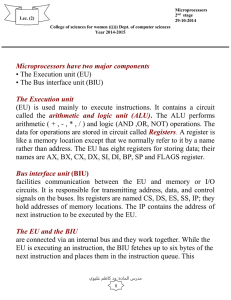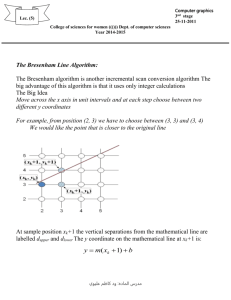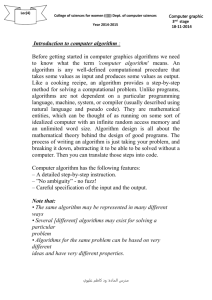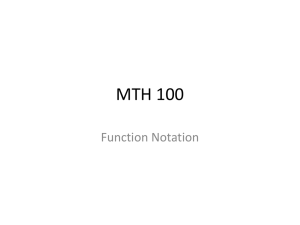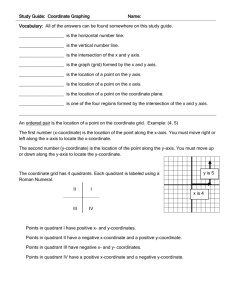Document 12656539
advertisement
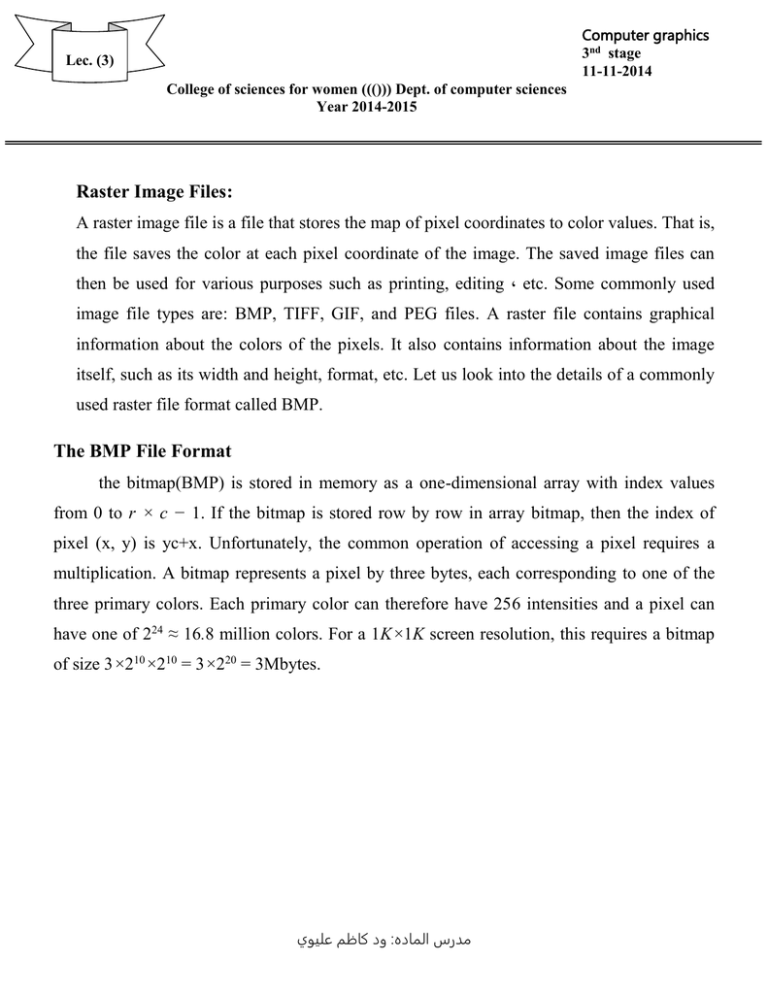
Computer graphics 3nd stage 11-11-2014 Lec. (3) College of sciences for women ((())) Dept. of computer sciences Year 2014-2015 Raster Image Files: A raster image file is a file that stores the map of pixel coordinates to color values. That is, the file saves the color at each pixel coordinate of the image. The saved image files can then be used for various purposes such as printing, editing ، etc. Some commonly used image file types are: BMP, TIFF, GIF, and PEG files. A raster file contains graphical information about the colors of the pixels. It also contains information about the image itself, such as its width and height, format, etc. Let us look into the details of a commonly used raster file format called BMP. The BMP File Format the bitmap(BMP) is stored in memory as a one-dimensional array with index values from 0 to r × c − 1. If the bitmap is stored row by row in array bitmap, then the index of pixel (x, y) is yc+x. Unfortunately, the common operation of accessing a pixel requires a multiplication. A bitmap represents a pixel by three bytes, each corresponding to one of the three primary colors. Each primary color can therefore have 256 intensities and a pixel can have one of 224 ≈ 16.8 million colors. For a 1K×1K screen resolution, this requires a bitmap of size 3×210×210 = 3×220 = 3Mbytes. ود كاظم عليوي:مدرس الماده Bitmap image Palette Figure (5) color lookup table (Palette) The data in BMP files is stored sequentially in a binary format and is sometimes compressed. Table (1) shows the basic format of the bmp file. Header Image Information palette Pixel data Table (1) The first part of the file is the header. The header contains information about the type of image ( BMP), its size, and the position of the actual image data in memory with respect to the start of the file. The second part of the BMP file is the image information section that contains the image width and height and type of compression. The third part is the palette that explain above and the forth part contain the pixel information (pointer to the color in the palette). ود كاظم عليوي:مدرس الماده Coordinate Graphing Coordinate graphing sounds very dramatic but it is actually just a visual method for showing relationships between numbers. The relationships are shown on a coordinate grid. A coordinate grid has two perpendicular lines, or axes, labeled like number lines. The horizontal axis is called the x-axis. The vertical axis is called the y axis. The point where the x-axis and y-axis intersect is called the origin. The numbers on a coordinate grid are used to locate points. Each point can be identified by an ordered pair of numbers; that is, a number on the x-axis called an x-coordinate, and a number on the y-axis called a ycoordinate. Ordered pairs are written in parentheses (x-coordinate, y-coordinate). The origin is located at (0,0). Note that there is no space after the comma. The location of (2,5) is shown on the coordinate grid below. The x-coordinate is 2. The y-coordinate is 5. To locate (2,5), move 2 units to the right on the x-axis and 5 units up on they-axis. The order in which you write x- and ycoordinates in an ordered pair is very important. The x-coordinate always comes first, followed by the y-coordinate. As you ود كاظم عليوي:مدرس الماده can see in the coordinate grid below, the ordered pairs (3,4) and (4,3) refer to two different points! The function table below shows the x- and ycoordinates for five ordered pairs. You can describe the relationship between the xand y-coordinates for each of these ordered pairs with this rule: the x-coordinate plus two equals the y-coordinate. You can also describe this relationship with the algebraic equation x + 2 = y. xcoordinate x+2 =y ycoordinate ordered pair 0 0+2 =2 2 (0,2) 1 1+2 =3 3 (1,3) 2 2+2 =4 4 (2,4) 3 3+2 =5 5 (3,5) 4 4+2 =6 6 (4,6) To graph the equation x + 2 = y , each ordered pair is located on a coordinate grid, then the points are connected. Notice that the graph forms a straight line. The arrows indicate that the line goes on in both directions. The graph for any simple addition, subtraction, multiplication, or division equation forms a straight line. ود كاظم عليوي:مدرس الماده Scan conversion is the process of converting basic, low level objects into their corresponding pixel map representations. This is often an approximation to the object, since the frame buffer is a discrete grid. there are two steps are necessary in order to display a geometric figure: (1) a scan-converting algorithm should be executed to select the best pixels (the ones closest to the ideal figure). (2) the selected pixels should be turned on. Step 2 is simple. It only requires setting bits in the bitmap. Most current compilers have a built-in function to do this. All that the program has to say is PSet(row,col) or plot(r,c,color). Step 1 is more complex. The scan-converting algorithm has to be fast and it must depend on the shape of the figure. ود كاظم عليوي:مدرس الماده A raster-scan system displays an object as a set of discrete points across each scan line. Frame buffer This memory area holds the set of intensity values for all the screen points. Stored intensity values are then retrieved from the refresh buffer and "painted" on the screen one row (scan line) at a time Each screen point is referred to as a pixel or pel (shortened form of picture element). The capability of a raster-scan system to store intensity information for each screen point makes it well suited for the realistic display of scenes containing subtle shading and color patterns. Home television sets and printers are examples of other systems using raster-scan methods. The term pixel is also used to describe the row and column location in the frame buffer array that corresponds to the screen location .A size 512*512 display screen required (262144) pixels memory location. ود كاظم عليوي:مدرس الماده مدرس الماده :ود كاظم عليوي
